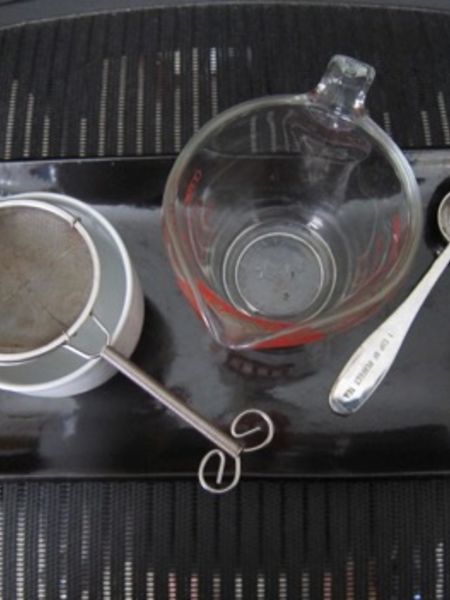No Teapot? No Worries!


Try This Triad of Kitchen Staples for Brewing
Part of the pleasure of tea-drinking is gathering up equipage from all around the world: Chinese gaiwans and Yixing pots, fragrance cylinder cups and tiny thimble drinking cups from Taiwan, side-handled pots from Korea, Japanese chanoyu tools, British Brown Bettys and fine porcelain cups from Germany, Russia, Ireland, Czechoslovakia or U.S. earthenware cups and mugs. Collecting these items is a great pleasure and makes sharing tea with others more festive and tea sipping solo more special.
I confess, my cupboards hold examples of ALL of these, and more, and I enjoy them all immensely. Despite the pleasure they give me, sometimes it’s just a good cup of tea I want, nothing fancy, nothing fussy, so that’s when I turn to my basic three-some: Measuring Cup, Measuring Spoon, and a stainless steel-handled food Sieve. I can hear a few eeeewwwws, but the objective is always a great cup of tea, and this method is simple and provides a satisfying tea-drinking experience.
I discovered this method when housesitting for a friend only to discover that she had a wide choice coffee paraphernalia (a Swiss Gold filter and an espresso machine with milk steamer, and a moka pot AND an expensively complicated electric coffeemaker) but nothing resembling a teapot much less one with a built in strainer. Looking through the cupboards of the kitchen, I found no fine Meissen pot nor a chipped crockery bowl. Nothing. There I was, aching to brew some tea (I always bring my own tea when staying anywhere,) and nothing to brew it in.
Finally, I did discover a solution: the spoon, the cup, and the sieve, and took so much fun in this, I adopted it as my umpteenth way of brewing tea.
Here’s how they make great tea:
Some things I’ve learned over years of writing and drinking tea are that one can “guesstimate” quantities fairly well after much practice, but using a measuring spoon provides for a more accurate quantity of tea (and zero waste) and filling a measuring cup with just the right amount of water provides more flavor in the cup, avoiding a diluted cup. Every single time. This is true when you use a teapot, so I always measure out the water to pour into my teapots.
I do fiddle with strainers with my primitive method. I have a flexible red silicone one a friend gave me that I keep more out of sentiment than practicality mainly because it’s too big to fit into some of my smaller cups. I gave up silver-plate strainers, pretty though they are, because after a few baths of boiled water, the cheap ones lose their silver plating and the toxic brass underneath is exposed. The most reliable are 18/8 stainless steel and a plethora of wonderful ones are available. They give you a true, clean cup, are easy to rinse off, and even though they can discolor from the tea, if that’s not to your liking, the discoloration can easily be cleaned off with a bit of elbow grease and a fine woven scrubber (skip the soap or harsh cleanser.) Choose strainers with a bit of weight to them as the stronger they are the longer they will last. Ditto for choosing sieves; go for all-stainless steel vs plastic handles and for bowls that are made of tightly-woven stainless steel mesh so that you’re not drinking a cup of dust and fannings that can fall through the holes. You’ll find great choices in any housewares department or culinary shop. Adagio’s matcha strainer is perfect!
Surprisingly, Pyrex and Anchor Hocking clear glass measuring cups are not as common as they once were, nor as well-made as they once were. You’ll find more made with silicone, plastics, and aluminum ones than heavy glass. I swear by the Pyrex-style cup as they are heat resistant and clearly marked with both ounces and millimeters, perfect for those who know either or both measurements. I have quite a collection now, gathered up for change from various thrift shops. They are allegedly breakable but I’ve never broken a one or even chipped the rims, so they are Reliable. The other great thing about glass measuring cups is they come in different sizes (one, two and four being the most common) so you can use this way of brewing tea for company, although I suggest doing it in the kitchen away from guests who’ll never know. All your guests care about anyway is the pleasure in the cup and your company.
I’m not suggesting that this be your one-and-only tea-brewing method, but do recommend it as a simple way to make tea no matter where you find yourself, especially if you’re somewhere that folks (egads!) do not drink tea.
Bon appetite!
